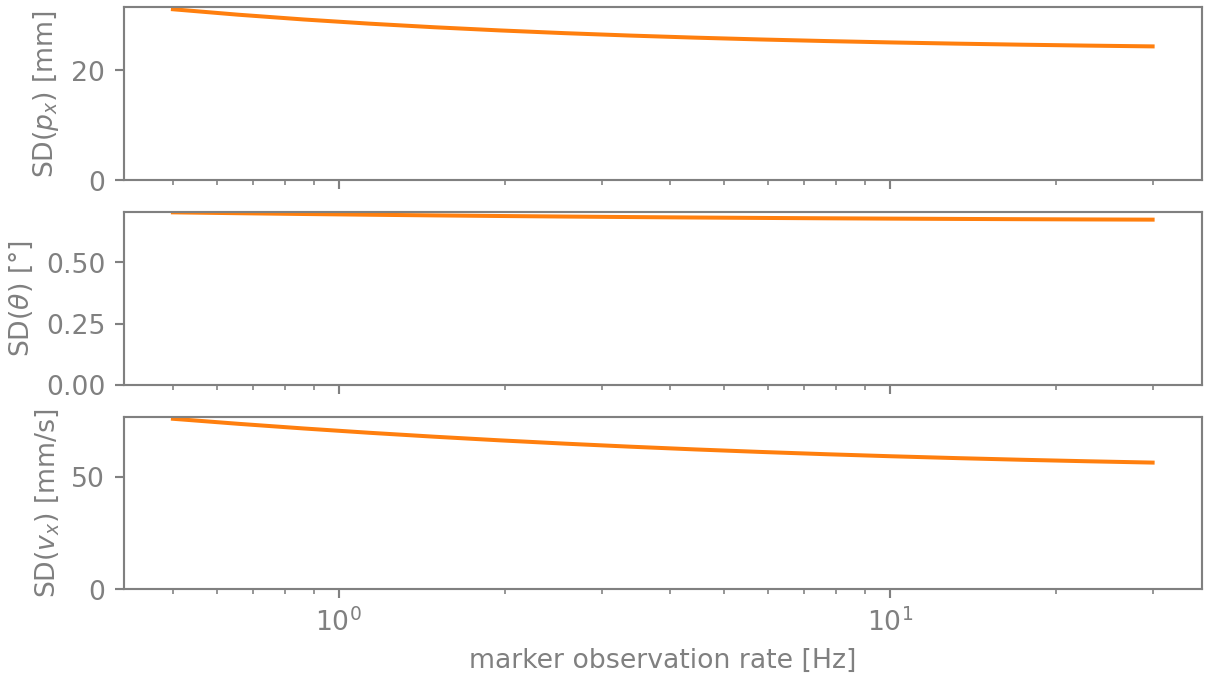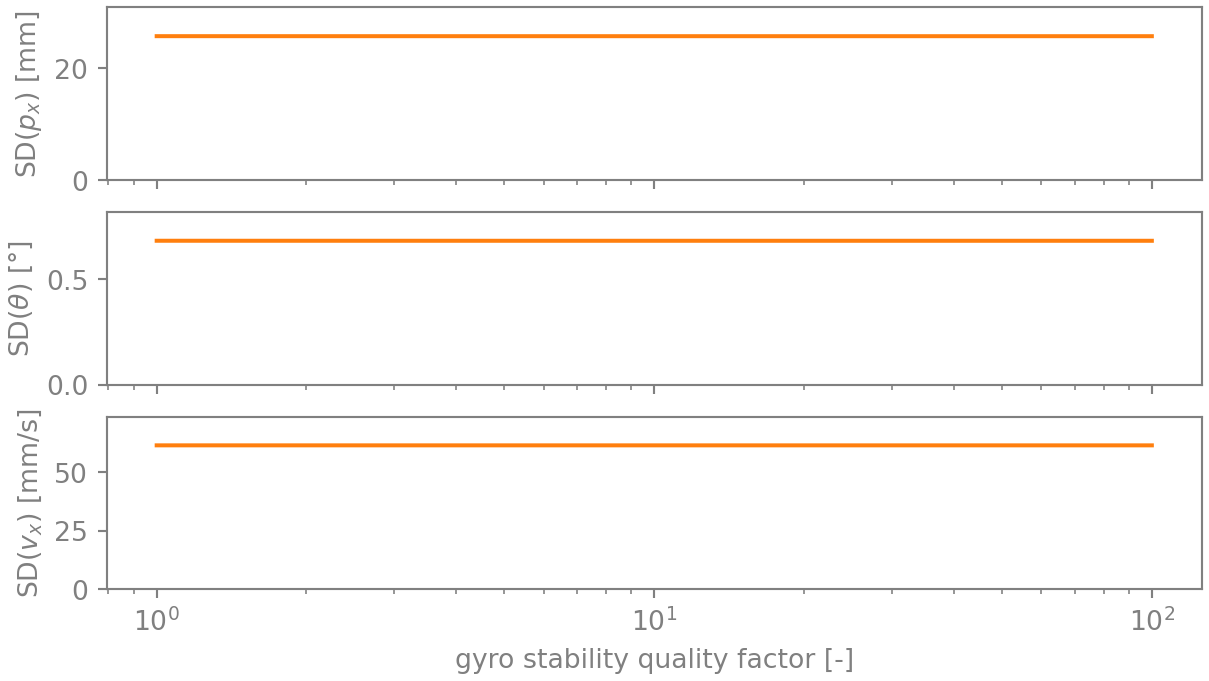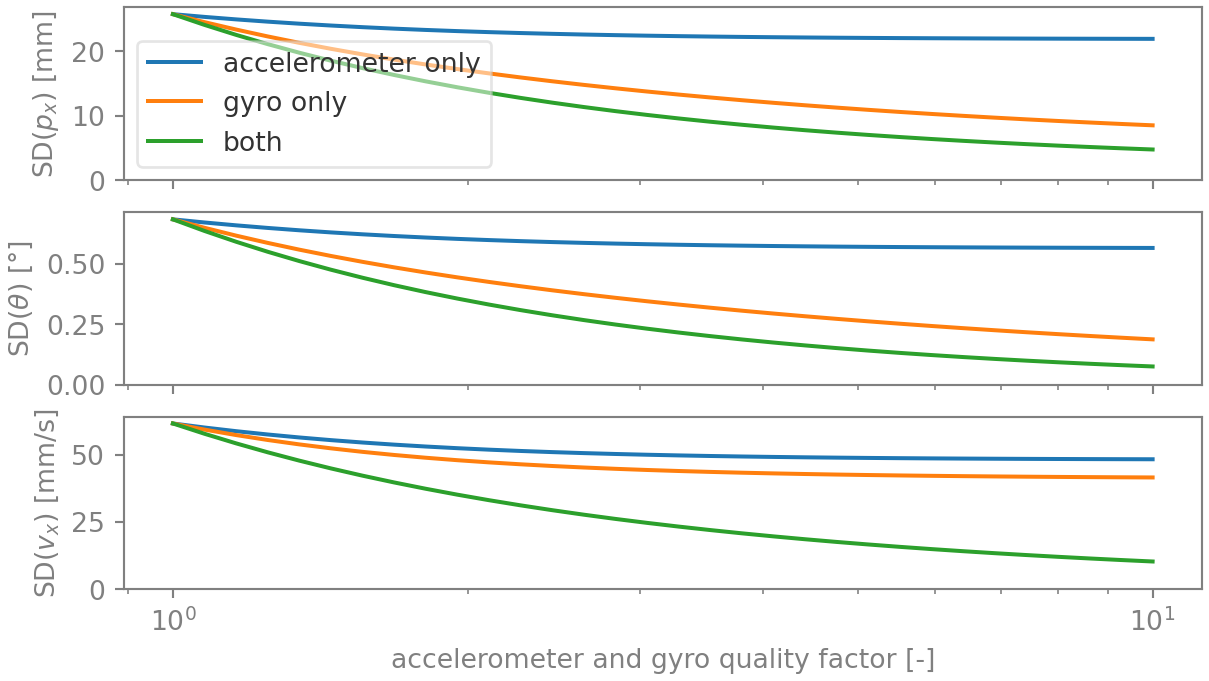Sensor fusion: be sure of uncertainty
Update 2025-08-17: applied minor corrections.
Intro
In case you’ve dabbled in state estimation, there’s a good chance you already encountered the following story: selected some sensors, picked an algorithm (usually Kalman or LQE), spent significant time on implementation and debugging, and then came to the conclusion that the resulting estimate is too noisy. Iteration, trying out other sensors and filter configurations, eventually made for a satisfying result, at the expense of lots of time spent coding and setting up experiments.
Now, here’s the thing: one can gather 90 % of those design insights with just a fraction of the implementation work, and even omit running the full filter (in simulation or real-world) entirely. That requires a few targeted shortcuts, and this article shows how.
To discuss the approach, we’ll go through the design of an estimation system for an autonomous multirotor landing on a visual marker. The used four-state Kalman filter is a simplified version of the one I developed for my master’s thesis.
After a brief discussion of the challenge at hand, the first step is to write out the system matrices. Thereafter we cover the covariance matrices. The final step is to evaluate the relation of sensor noisiness on the state estimate covariance to find out what sensing system improvements will increase performance most effectively. In particular, we’ll see how influential the marker observation rate is, and whether it’s the camera, the gyro or the accelerometer that are to be improved.
Math terms
Key used symbols (lowercase for vectors, uppercase for matrices):
| Symbol | Name |
|---|---|
| \(\mathbf{x}\) | State |
| \(\mathbf{P}\) | State covariance |
| \(\mathbf{u}\) | Propagation input |
| \(\mathbf{z}\) | Measurement |
| \(\mathbf{A}\) | Propagation system |
| \(\mathbf{B}\) | Propagation input sensitivity |
| \(\mathbf{H}\) | Measurement sensitivity |
| \(\mathbf{Q}\) | Propagation covariance |
| \(\mathbf{R}\) | Measurement covariance |
The matrices \(\mathbf{A}\) and \(\mathbf{Q}\) have discretized variants which are represented as \(\mathbf{A_d}\) and \(\mathbf{Q_d}\).
The challenge: autonomous multirotor landing localization
Figure 1 illustrates the challenge: a drone flies above the marker, keeping position while descending. Ground effects and increased turbulence make this situation challenging, and the feedback control system requires a solid source of where the drone finds itself above the marker - it requires a state estimate.

The state vector \(\mathbf{x}\) contains the kinematic state of the drone - position and velocity - as well as a bias term for the gyro (the accelerometer x-axis bias is omitted because of its poor observability):
\[\begin{align*} \mathbf{x} &= \begin{bmatrix} p_x & \theta & v_x & b_\omega\end{bmatrix}^\mathsf{T} \\ \mathbf{u} &= \begin{bmatrix} \omega & a_x \end{bmatrix}^\mathsf{T} \end{align*}\]The multirotor’s vertical position, \(p_y\) is not estimated here because it’s not used by the horizontal position controller. As sensor we have at our disposal an IMU (gyro + accelerometer) and a camera that observes the marker. The IMU provides angular velocity and linear accelerations, combining up to the propagation vector \(\mathbf{u}\). On the other hand, the marker detector delivers measurements \(\mathbf{z} = \begin{bmatrix} z_x \end{bmatrix}^\mathsf{T}\), we get the relative position of the marker (no orientation - we’ll analyze the impact of that later). The marker lies at the origin.
Symbol table with those that will receive use further on:
| Symbol | Name |
|---|---|
| \(p_x, p_y\) | Multirotor position |
| \(\theta\) | Multirotor tilt |
| \(v_x\) | Multirotor velocity along the x-axis |
| \(b_\omega\) | Gyro bias |
The filter: limited design
System matrices
Now, instead of designing and coding up a Kalman filter that handles this challenge in full, we’ll limit ourselves to writing out the system matrices and apply the following simplifications:
- 1D instead of 3D. Two instead of 6 DoF, and no quaternions.
- Linear instead of extended. We select one representative state and linearize while modelling.
- Constant input covariances. As the system operates in a particular, representative situation, \(\mathbf{R}\) and \(\mathbf{Q}\) are kept constant.
In this case, we’ll choose the representative state to be somewhere exactly above the marker. As a result, sines and cosines drop away. For completeness, these are the three system matrices derived after applying the above (with \(g\) = 9.81 m/s²):
\[\newcommand{\gz}[0]{\color{grey}0} \begin{align*} \dot{\mathbf{x}} &= \mathbf{A} \, \mathbf{x} + \mathbf{B} \, \mathbf{u} \\ &= \begin{bmatrix} \begin{matrix} \gz & \gz & 1 & \gz \\ \gz & \gz & \gz & -1 \\ \gz & -g & \gz & \gz \\ \end{matrix} \\ \color{grey} \mathbf{0}_{1 \times 4} \end{bmatrix} \cdot \begin{bmatrix} p_x \\ \theta \\ v_x \\ b_\omega \end{bmatrix} \, + \, \begin{bmatrix} \color{grey} \mathbf{0}_{1 \times 2} \\ \mathbf{I}_{2 \times 2} \\ \color{grey} \mathbf{0}_{1 \times 2} \\ \end{bmatrix} \cdot \begin{bmatrix} \omega \\ a_x \end{bmatrix} \\ \\ \mathbf{z} &= \mathbf{H} \, \mathbf{x} \\ \begin{bmatrix} z_x \end{bmatrix} &= \begin{bmatrix} \begin{matrix} 1 & p_y & \gz & \gz \\ \end{matrix} \end{bmatrix} \cdot \mathbf{x} \end{align*}\]Matrix \(\mathbf{A}\) is converted to discrete with \(\newcommand{\gz}[0]{\color{grey}0} \begin{align*} \mathbf{A_d} &= \mathbf{I}_{4 \times 4} \, + \, \mathbf{A} \: f_{prop} \end{align*}\) where \(f_{prop}\) is the Kalman filter propagation rate, which in this application equals the gyro measurement rate (a usual value for this is 200 Hz).
As an exercise, one can work out this case in 2D and 3D, adding states for the y-axis position and velocity and an accelerometer bias, and obtain the same results for \(p_x\)’s uncertainty.
Noise matrices Q and R
These two matrices respectively represent the uncertainty associated with state propagation and measurements.
The construction of \(\mathbf{Q}\) won’t be discussed in detail; suffice to say that it is a combination of input noises from the IMU (\(w_g\) and \(w_a\)) and the gyro bias drift velocity (\(w_{b\omega}\)). For reference, this results in the following expression:
\[\begin{align*} \mathbf{Q} &= \mathbf{B} \, \begin{bmatrix} w_g & \\ & w_a \\ \end{bmatrix} \, \mathbf{B}^\mathsf{T} \, + \, \begin{bmatrix} \color{grey} \mathbf{0}_{3 \times 3} \\ & \begin{matrix} w_{b\omega} \\ \end{matrix} \end{bmatrix} \\ \mathbf{Q_d} &= \mathbf{Q} \: \frac{1}{f_{prop}} \\ \mathbf{R} &= \, \begin{bmatrix} v_p (p_y / f)^2 \\ \end{bmatrix} \end{align*}\]with \(v_p\) the variance on the detected marker position in pixels squared, \(f\) the camera focal length in pixels and \(m_s\) the marker size in m. (The IMU parameters are expressed in continuous time, so the resulting \(\mathbf{Q}\) is continuous as well, hence necessiting the conversion to discrete thereafter.)
The construction of \(\mathbf{R}\) benefits from a brief discussion, as it’s responsible for some of the key results encountered in the next section. It’s assumed that the noise on the marker’s corner positions in the image plane is constant (symbol \(v_p\)); projecting this error to the world then gives rise to the scale effects.
Great, we’re past the math now. Let’s see what story these matrices can tell us!
Sensitivity analysis
The method is simple: run the Kalman filter’s covariance calculations (propagation and correction at their respective rates, which doesn’t require any measurement values), and once converged get the covariance at the step just before the correction (as the covariance is the highest at that instant). Do so for several parameter values, and a sensitivity plot rolls out. The two key state values of interest are the horizontal position \(p_x\) and velocity \(v_x\), as these are required for the horizontal position feedback controller. The system will be linearized around \(p_y\) = 2.0 m and the marker detection error \(v_p\) is assumed to be 1 px² (a large value, as a well-calibrated camera allows subpixel precision).
Note In case of a synchronous Kalman filter (with a correction after each propagation), running the filter can be omitted in favor of synthesizing an LQE with the above matrices by solving the Riccati equation, which next to a gain matrix returns the desired measure - the state estimate covariance matrix \(\mathbf{P}\).
Sensitivity to marker observation rate
Our current marker observation rate is 5 Hz. If we see the marker more often, then our position estimate must improve, no? Let’s see. Figure 2 plots the root variance on \(p_x\) for an observation rate ranging from 5 to 60 Hz:

As expected, the improvement is there, though small it is: just 30 %. What is happening here? To uncover this, first have a look at \(\mathbf{R}\). The observation uncertainty on the markers relative x-axis position is only 3.1 mm, a fraction of the drone’s position uncertainty. The root challenge here is that that the relative observation has to be transformed to the world frame, and here the drone’s attitude \(\theta\) comes into play. Or actually, its covariance, as any uncertainty on it increases the uncertainty on the result. The orientation uncertainty is 0.72 ° - at a distance of 2.0 m, that makes for an uncertainty of 25 mm. Put differently, at a rate of 5 hz the position uncertainty of 34.8 mm is already mainly due to attitude uncertainty, and not due to the marker observation (which is already close to perfect). Camera improvements, such as executing more observations or increasing resolution, hence fail to add significant value. (Though note that one shouldn’t lower the observation rate either, as the sensitivity becomes large at only slightly lower rates.)
Use marker orientation?
Given the attitude uncertainty, an additional observer would be welcome. A view on a visual marker such as an AprilTag provides both position and orientation, hence why not use it? The issue here lies in the variance magnitudes. Marker detection precision is in the order of several degrees, and that is considerably higher than the drone’s attitude uncertainty. Therefore, the marker orientation carries little relevant information. (An exception would be if the marker observation rate would be sufficiently high to average out the orientation noise, but in practice the required rate tends to be higher than what the drone’s processing units are capable of.)
So let’s go for a more stable gyro, then?
A basic characterization of a gyro or accelerometer consists of two values: measurement noise and bias drift velocity. The better IMUs have a built-in heater that maintains the sensor at constant temperature, as the bias drift velocity is temperature dependent. The result is a gyro that is more stable. Figure 3 shows what difference a 100-fold more stable gyro makes for this case: close to negligible. The reason for this is simple: the bias is easily estimated anyway, so improving that estimate even further by decreasing the rate of change yields diminished returns.

Does reducing gyro or accelerometer noise help?
The two remaining parameters are then the gyro and accelerometer observation noises. Intuitively, it may seem that the latter is the most determining; after all, velocity and position are integrals of acceleration. On the other hand, lower gyro noise improves the attitude estimate, in turn reducing the uncertainty on the transformed marker position. Figure 4 graphs the effect - and it’s a bit of both: for \(p_x\), it’s the gyro that rules, while for \(v_x\), both are necessary to obtain a substantial improvement.

The latter result is particularly interesting. A better gyro on its own improves the attitude, but the velocity uncertainty remains high because of the noisy acceleration measurements (which effectively results in the velocity being estimated from the position observations). Meanwhile, only improving the accelerometer doesn’t yield gains as it doesn’t help in curbing the attitude uncertainty.
Conclusion: the way forward is to go for an IMU with a less noisy gyro and accelerometer.
Conclusion
Through this exploration of sensor fusion for autonomous multirotor landing, we unveiled insights that streamline the design of state estimation systems. Writing out the system matrices, running only the covariance part of the Kalman filter and performing sensitivity analyses allowed us to obtain many of the design insights that otherwise require simulating the full filter as well as the system around it.
The key takeaway here is that this approach allows to bypass extensive implementation and simulation, letting us zero in on what really matters in the design phase. It empowers engineers and researchers to quickly assess the impact of different sensor configurations and noise characteristics on state estimation accuracy, and as such enables informed decisions early in the development process.
Did you apply similar techniques? What would you like to see discussed next? Share in the comments!
Enjoy Reading This Article?
Here are some more articles you might like to read next: